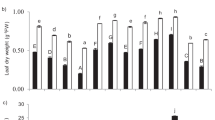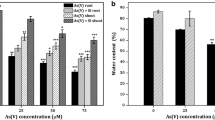Abstract
The effect of arsenate and selenate, either alone or in combination, on plant growth and nitrogen metabolism was studied in wheat seedlings. The root-shoot elongation and the biomass production were significantly decreased with increasing arsenate concentrations. Arsenate toxicity severely affected activities of different antioxidant scavenging enzymes and oxidative stress markers in the test seedlings. The activities of nitrate and nitrite reductase were also affected resulting in reduced nitrate and nitrite contents. Glutamine synthetase and glutamate synthase activities were also reduced, whereas the glutamate dehydrogenase activity was substantially increased resulting in an increased accumulation of ammonium contents in the test seedlings. Arsenate treatments also adversely affected the levels of total and soluble nitrogen contents and free amino acid contents. Combined application of arsenate with selenate in the test seedlings showed significant alterations in all parameters tested under the purview of arsenate treatment alone leading to better growth and nitrogen metabolism.










Similar content being viewed by others
Abbreviations
- As:
-
Arsenic
- CAT:
-
Catalase
- EDTA:
-
Ethylenediamine tetraacetic acid
- Fw:
-
Fresh weight
- GDH:
-
Glutamate dehydrogenase
- GOGAT:
-
Glutamate synthase
- GS:
-
Glutamine synthetase
- H2O2 :
-
Hydrogen peroxide
- NBT:
-
Nitroblue tetrazolium
- NEDH:
-
N-(1-napthyl) Ethylenediamine dihydrochloride
- NiR:
-
Nitrite reductase
- NR:
-
Nitrate reductase
- PFD:
-
Photon flux density
- ROS:
-
Reactive oxygen species
- Se:
-
Selenium
- SE:
-
Standard error
- SOD:
-
Superoxide dismutase
- TCA:
-
Trichloroacetic acid
References
Bates LS, Waldren RP, Treare ID (1973) Rapid estimation of free proline for water stress determination. Plant Soil 39:205–207
Canovas FM, Canton FR, Gallardo F, Garcia-Gutierrez A, de Vincente A (1991) Accumulation of glutamine synthetase during early development of maritime pine (Pinus pinaster) seedlings. Planta 185:372–378
Carbonell-Barrachina AA, Burlo-Carbonell F, Mataix-Beneyto J (1995) Arsenic uptake, distribution, and accumulation in tomato plants: effect of arsenic on plant growth and yield. J Plant Nutr 18:1237–1250
Cataldo DA, Haroon M, Schrader LE, Youngs VL (1975) Rapid colorimetric determination of nitrate in plant tissue by nitration of salicylic acid. Commun Soil Sci Plant Anal 6:71–80
Chaffei C, Pageau K, Suzuki A, Gouia H, Ghorbel MH, Masclaux-Daubresse C (2004) Cadmium toxicity induced changes in nitrogen management in Lycopersicon esculentum leading to a metabolic safeguard through an amino acid storage strategy. Plant Cell Physiol 45:1681–1693
Chen FL, Cullimore JV (1988) Two isoenzymes of NADH-dependent glutamate synthase in root nodules of Phaseolus vulgare L. Purification, properties and activity changes during nodule development. Plant Physiol 88:1411–1417
Choudhury B, Chowdhury S, Biswas AK (2011) Regulation of growth and metabolism in rice (Oryza sativa L.) by arsenic and its possible reversal by phosphate. J Plant Interact 6(1):15–24
Das D, Pradhan S, Biswas AK (2011) Influence of Selenium on growth and metabolism in Rice (Oryza sativa L) and its possible interaction with Sulphate. Indian J Plant Physiol 16:35–48
Djanaguiraman M, Durga-Devi D, Shanker AK, Sheeba JA, Bangarusamy U (2005) Selenium—an antioxidative protectant in soybean during senescence. Plant Soil 272:77–86
Dubey RS, Pessarakli M (2002) Physiological mechanisms of nitrogen absorption and assimilation in plants under stressful conditions. In: Pessarakli M (ed) Handbook of Environmental Toxicology and Chemistry. IOS Press, Amsterdam, pp 2982–2986
Feng R, Wei C, Tua S, Sunb X (2009) Interactive effect of selenium and arsenic on their uptake by Pteris vittata L. under hydroponic conditions. Environ Exp Bot 65:363–368
Finley JW, Ip C, Lisk DJ, Davis CD, Hintze KJ, Whanger PD (2001) Cancer-protective properties of high-selenium broccoli. J Agric Food Chem 49:2679–2683
Frans R, Horton D, Burdette L (1988) Influence of MSMA on straighthead, arsenic uptake and growth response in rice (Oryza sativa). Ark Agric Exp Stat Rep 302:1–12
Frost DV, Lish PM (1975) Selenium in biology. Annu Rev Pharma 15:259–284
Gajewska E, Skłodowska M (2009) Nickel-induced changes in nitrogen metabolism in wheat shoots. J Plant Physiol 166(10):1034–1044
Gasper T, Laccoppe J (1968) The effect of CCC and AMO-1618 on growth, catalase, peroxidase, IAA oxidase activity of young barley seedlings. Plant Physiol 21:1104–1109
Giannopolitis CN, Ries SK (1977) Superoxide dismutases I. Occurrence in higher plants. Plant Physiol 59:309–314
Gratao PL, Polle A, Lea PJ, Azevedo RA (2005) Making the life of heavy metal-stressed plants a little easier. Funct Plant Biol 32:481–494
Hageman RH, Reed AJ (1980) Nitrate reductase from higher plants. Methods Enzymol 69:270–280
Hartikainen H, Xue TL, Piironen V (2000) Selenium as an anti-oxidant and prooxidant in ryegrass. Plant Soil 225:193–200
Hartley-Whitaker J, Ainsworth G, Meharg AA (2001) Copper and arsenate-induced oxidative stress in Holcus lanatus L. clones with differential sensitivity. Plant Cell Environ 24:713–722
Hoshida H, Tanaka Y, Hibino T, Hayashi Y, Tanaka A, Takabe T, Takabe T (2000) Enhanced tolerance to stress tolerance in transgenic rice that overexpresses chloroplast glutamine synthetase. Plant Mol Biol 43:103–111
Kavi Kishor PB, Sangam S, Amrutha RN, Laxmi P, Naidu KR (2005) Regulation of proline biosynthesis, degradation, uptake and transport in higher plants: its implications in plant growth and abiotic stress tolerance. Curr Sci 88:424–438
Knauer K, Behra R, Hemond H (1999) Toxicity of inorganic and methylated arsenic to algal communities from lakes along an arsenic contamination gradient. Aqua Toxicol 46:221–230
Kong L, Wang M, Bi D (2005) Selenium modulates the activities of antioxidant enzymes, osmotic homeostatis and promotes the growth of sorrel seedlings under salt stress. Plant Growth Regul 45:155–163
Kumar S, Joshi UN (2008) Nitrogen metabolism as affected by hexavalent chromium in sorghum (Sorghum bicolor L.). Environ Exp Bot 64:135–144
Kumar RG, Shah K, Dubey RS (2000) Salinity-induced behavioural changes in malate dehydrogenase and glutamate dehydrogenase activities in rice seedlings of differing salt tolerance. Plant Sci 156:23–34
Kuznetsov VV, Kholodova VP, Kuznetsov VIV, Yagodin BA (2003) Selenium regulates the water status of plants exposed to drought. Dokl Biol Sci 390:266–268
Kwinta J, Cal K (2005) Effects of salinity stress on the activity of glutamine synthetase and glutamate dehydrogenase in triticale seedlings. Pol J Environ Stu 14:125–130
Lea PJ, Ireland RJ (1999) Nitrogen metabolism in higher plants. In: Singh BK (ed) Plant Amino acids, Biochemistry and Biotechnology. Marcel Dekker, New York, pp 1–47
Lee YP, Takahashi T (1966) An improved Colorimetric determination of amino acids with the use of ninhydrin. Anal Biochem 14:71
Lowry OH, Rosebrough NJ, Farr AL, Randall RJ (1951) Protein measurement with the Folin phenol reagent. J Biol Chem 193:265–275
Meharg AA (1994) Ecological impact of major industrial chemical accident. Rev Environ Contam Toxicol 138:21–48
Meharg AA, Macnair MR (1992a) Suppression of the high affinity phosphate uptake system: a mechanism of arsenate tolerance in Holcus lanatus L. J Exp Bot 43:519–524
Meharg AA, Macnair MR (1992b) Polymorphism and physiology of arsenate tolerance in Holcus lanatus L. from an uncontaminated site. Plant Soil 146:219–225
Melo PM, Lima LM, Santos IM, Carvalho HG, Cullimore JV (2003) Expression of the plastid located glutamine synthetase of Medicago truncatula and accumulation of the precursor in root nodules reveals an in vivo control at the level of protein import into plastids. Plant Physiol 132:390–399
Mittler R (2002) Oxidative stress, antioxidant and stress tolerance. Trends Plant Sci 7:405–410
Mylona PV, Polidoros AN, Scandalios JG (1998) Modulation of antioxidant responses by arsenic in maize. Free Rad Biol Med 25:576–585
Shah K, Dubey RS (2003) Environmental stresses and their impact on nitrogen assimilation in higher plants. In: Hemantranjan A (ed) Advances in plant physiology. Scientific Publishers, Varanasi, pp 219–225
Singh R, Srivastava HS (1986) Increase in glutamate synthase (NADH) activity in maize seedlings in response to nitrate and ammonium nitrogen. Plant Physiol 66:413–416
Singh N, Ma LQ, Srivastava M, Rathinasabapathi R (2006) Metabolic adaptations to arsenic-induced oxidative stress in Pteris vittata L. and Pteris ensiformis L. Plant Sci 170:274–282
Snell FD, Snell CT (1949) Colorimetric methods of analysis, 2. Van Nostrand, New Jersey
Srivastava M, Ma LQ, Singh N, Singh S (2005) Antioxidant responses of hyperaccumulator and sensitive fern species to arsenic. J Exp Bot 56:1332–1342
Stoeva N, Bineva T (2003) Oxidative changes and photosynthesis in oat plants grown in As-contaminated soil. Bulg J Plant Physiol 29:87–95
Stone JR, Yang S (2006) Hydrogen peroxide: a signaling messenger. Antioxid Redox Sign 8:243–270
Thurman RG, Ley HG, Scholz R (1972) Hepatic microsomal ethanol oxidation and hydrogen peroxide formation and role of catalase. Eur J Biochem 25:420–430
Vega JM, Jacobo C, Manuel M (1980) Purification and molecular properties of nitrite reductase from Anabaena sp. 7119. Methods Enzymol 69:255–270
Vogel AI (1961) Colorimetric estimation of nitrogen by Nessler’s reagent. In: a textbook of quantitative inorganic analysis. Langman and Green, India, pp 97–108
Xue TL, Hartikainen H, Piironen V (2001) Antioxidative and growth-promoting effect of selenium on senescing lettuce. Plant Soil 237:55–61
Acknowledgments
This study was supported financially by a research grant obtained from the University Grants Commission, New Delhi, India. The authors are grateful to Professor S. Mukherji, Professor of Botany (Retd.), University of Calcutta for his valuable comments during preparation of the manuscript.
Author information
Authors and Affiliations
Corresponding author
Additional information
Communicated by L. A. Kleczkowski.
Rights and permissions
About this article
Cite this article
Ghosh, S., Saha, J. & Biswas, A.K. Interactive influence of arsenate and selenate on growth and nitrogen metabolism in wheat (Triticum aestivum L.) seedlings. Acta Physiol Plant 35, 1873–1885 (2013). https://doi.org/10.1007/s11738-013-1225-x
Received:
Revised:
Accepted:
Published:
Issue Date:
DOI: https://doi.org/10.1007/s11738-013-1225-x




